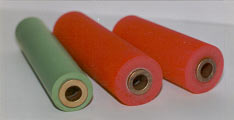ADIPRENE® CASTETHANE® VIBRETHANE®
SPECIFICATIONS:
None which are standard
NATURAL COLOUR:
TRANSLUCENT YELLOW/AMBER
Referred to as "elastoplastics" URETHANE materials span the range of materials called elastomers, having a softness lower than rubber bands to a hardness of tap washers, and over into plastics ranging from a softness of Polyethylene to a hardness greater than that of Cast Nylon. These ranges of hardness plus a great variety in properties such as tensile strength, elongation, tear strength, compression set resistance, etc. result from the method of manufacture of cast POLYURETHANES. These products are made from a two-part system. One component, a polyol, contains either a low molecular weight liquid Polyester or Polyether along with cross-linking agent and perhaps a catalyst, while the other component is an isocyanate terminated prepolymer. URETHANE shapes are produced by mixing the two components, pouring the thick liquid into a mould and heating slightly to cause the materials to react. Some "cold cast" systems are now on the market that avoid the heating step and can be easily used on a shop bench. Due to the wide range of each of the reaction components, there is a tremendous variety available as finished POLYURETHANES. The hardness of POLYURETHANE is often used to differentiate finished compounds. However, due to the very wide range of possible compounds, several, all having the same hardness, may greatly differ in their other properties. The majority of commercially available POLYURETHANES have very good abrasion resistance, excellent oil resistance, quite good electrical insulation properties, are almost completely resistant to ozone and oxygen degradation; the harder grades have high load bearing capacity with quite good impact resistance. Machining of POLYURETHANES varies from a problem to impossible. Due to inherent elasticity, even with the harder grades, the material tends to be deflected by the tool and this deflection becomes more pronounced with softer grades to the point where gouging and tearing takes place rather than cutting. With these softer grades, special techniques, such as cooling with carbon dioxide or nitrogen to increase stiffness and using special razor-like cutters, among other exotic ideas, are used. Since they are polar materials, POLYURETHANES bond well using urethane, epoxy and cyano-acrylate adhesives. Materials such as molybdenum disulphide, graphite and silicone oil can be added to improve wear and load bearing properties.
| GENERAL PROPERTIES | ||||||||
| ASTM test | Polyester Base | Polyether Base | ||||||
| 60A | 75A | 85A | 95A | 60D | 75D | |||
| SPECIFIC GRAVITY | D792 | 1.26 | 1.26 | 1.26 | 1.15 | 1.18 | 1.18 | |
| TENSILE STRENGTH | psi | D638 | 4500 | 5500 | 6000 | 5500 | 6500 | 7500 |
| TENSILE MODULUS | 105 psi | D638 | 0.05 | 0.15 | 0.25 | 0.50 | 1.20 | 1.30 |
| ELONGATION | % | D638 | 500 | 500 | 500 | 320 | 290 | 225 |
| FLEXURAL STRENGTH | psi | D790 | ||||||
| FLEXURAL MODULUS | 105 psi | D790 | 0.85 | 0.95 | ||||
| COMPRESSIVE STRENGTH | 10% psi | D695 | ||||||
| COMPRESSIVE MODULUS | 105 psi | D695 | ||||||
| HARDNESS | shore A | D2240 | 60A | 75A | 85A | 95A | ||
| shore D | D2240 | 60D | 75D | |||||
| IMPACT STRENGTH (1/2" x 1/2") | ft-lb/inch of notch | D256 | No Break | No Break | No Break | No Break | 1255 | |
| THERMAL EXPANSION | 10-5/°F | D696 | 11.0 | 5.0 | ||||
| HEAT RESISTANCE (continuous in air) | °F | 185 | 185 | 190 | 195 | 210 | 220 | |
| DEFLECTION TEMPERATURE | D648 | |||||||
| @ 264 psi | °F | N/A | N/A | N/A | 185 | |||
| @ 66 psi | °F | N/A | N/A | N/A | ||||
| DIELECTRIC STRENGTH | v/mil | D149 | 475 | 600 | ||||
| DIELECTRIC CONSTANT | D150 | 77 to 94 | 76 to 93 | |||||
| DISSIPATION FACTOR | 10-3 | D150 | 47 to 59 | 44 to 73 | ||||
| WATER ABSORPTION | 24hrs % | D570 | 0.7 | |||||
| FLAMMABILITY | in/min | D635 | 0.6 | |||||
Values shown in the above table are averages and there will be variances from lot to lot. After selecting a material based upon these values, you must conduct tests specific to your application to be assured the material suits your needs.

|
|
POLYURETHANE Label Pressure Rollers |
The colour of a POLYURETHANE product is no guide as to hardness, tear strength, solvent resistance, or any other property. It is simply one person's or one company's method of identifying a particular material. There are no industry standards for colour coding of POLYURETHANES. One reason some manufacturers colour POLYURETHANES is to mask bubbles in castings. Due to the viscosity of the liquid prepolymer, removing bubbles, before the material starts to set-up can prove quite difficult. Opaque colours hide this. And, provided these bubbles are not extensive, they often have little effect on the part.
Ether Base URETHANES are more hydrolysis and fungi resistant, have lower densities and better electrical insulation properties. Ester Base URETHANES have better wear and abrasion resistance, higher densities and better hydrocarbon and solvent resistance.